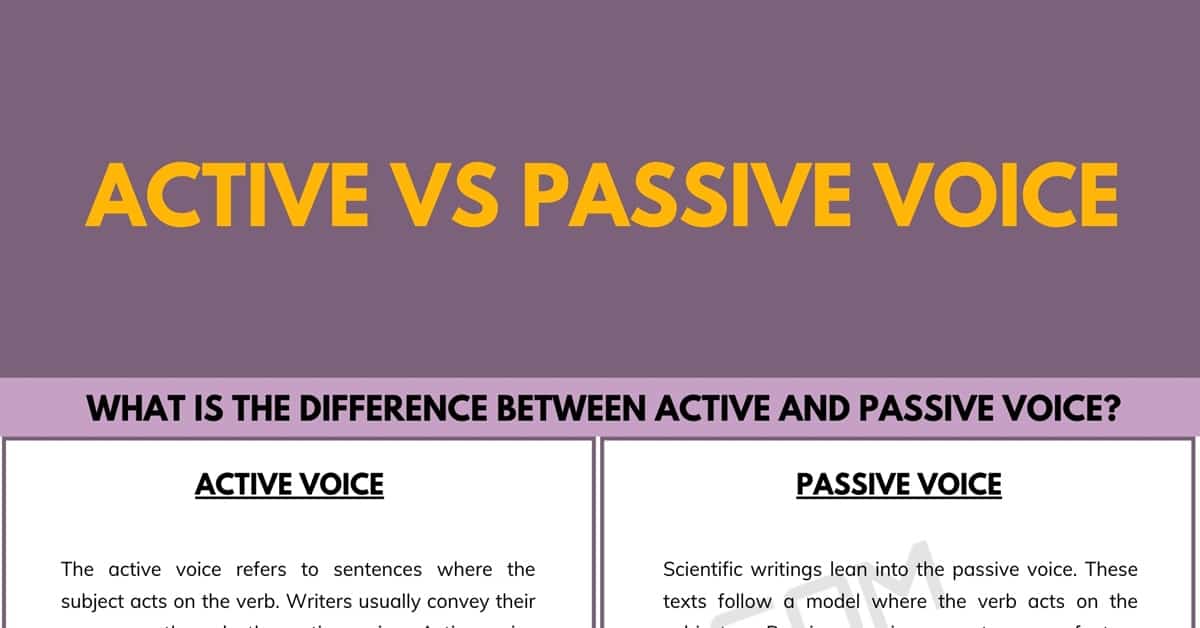What is the difference between active vs passive voice? There are five properties that can affect a verb: tense, voice, mood, number, and person. Through voice, the English language can become clearer or more obtuse. Two different voices impact our language construction: passive and active. The passive voice appears formal while the active voice seems conversational.
The Difference Between Active and Passive Voice
Active Voice
The active voice refers to sentences where the subject acts on the verb. Writers usually convey their messages through the active voice. Active voice employs clear and concise language. The active voice delivers a strong and straightforward tone.
Examples
- The boy hit the car.
- The cat ate the fish.
- People hate spiders.
The examples above showcase the basic construction of the active voice: subject, verb, and object. In the first sentence, “the boy” is the subject who completes the action “hit”. In the second sentence, “the cat” is the subject, and “ate” is the verb. “The cat” completes the action “ate”. The final sentence describes the subject “people” and the action “hate”.
Every example reveals that the subject is the one taking action. Without the subject, there would be no one to take action.
Passive Voice
Scientific writings lean into the passive voice. These texts follow a model where the verb acts on the subject. Passive voice sentences feature configurations of “to be” and the past participle. Besides, the passive voice can give rise to a preposition.
Examples
- The car was hit by the boy.
- The fish was eaten by the cat.
- The spiders were hated by people.
Compare the first set of examples, “the boy hit the car” and “the car was hit by the boy”, to establish the differences between the active and passive voice. The former active sentence follows an order: subject (the boy), verb (hit), and object (the car). In contrast, the latter passive voice employs a different sequence: object (the car), to be tense (was), verb past-participle (hit), preposition (by), and subject (the car).
The passive sentence is weak and convoluted when compared to the active one. The three passive sentences above introduced the preposition “by” when the structure twisted.
When Do You Use Passive or Active Voice?
Why use the passive voice?
Sometimes you will want to use the passive voice in your sentences. Like the active voice, the passive voice has a function to perform. Choose the passive voice when you want to emphasize a specific action but not the actor.
When you do not focus on the actors in your sentences it becomes easier to emotionally distance yourself from what you are reading. This allows the reader to dissect your work and look at its messages more objectively.
Distancing the reader from the narrative could have the opposite effect. The reader may become less interested in the discussed topics. The active voice needs to surround the passive voice passages. This allows passive sentences to stand out.
Use the passive voice when your subject is unknown. The structure of the passive voice makes it possible to omit a subject. You can manipulate the voice to keep people from discovering the culprit in your story.
As discussed earlier in the section, extra words give the appearance of intelligence. Invoking the passive voice may suggest the writer’s authority on a subject. Passive sentences seem more formal. You can interpret formality to mean professional. Using the passive voice leads the average reader to believe you know what you are talking about.
Active vs Passive Voice | Image








0 Comments